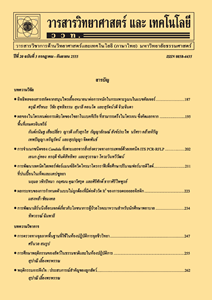ความแกร่งและอำนาจการทดสอบของสถิติอิงพารามิเตอร์และสถิติไม่อิงพารามิเตอร์ในการทดสอบความแตกต่างของค่ากลางระหว่างประชากรสองกลุ่ม สำหรับข้อมูลแบบลิเคิร์ท 5 ระดับ
Main Article Content
Abstract
บทคัดย่อ
การวิจัยครั้งนี้มีวัตถุประสงค์เพื่อศึกษาความแกร่งและอำนาจการทดสอบของสถิติอิงพารามิเตอร์และสถิติไม่อิงพารามิเตอร์ในการทดสอบความแตกต่างของค่ากลางระหว่างประชากรสองกลุ่ม สำหรับข้อมูลแบบลิเคิร์ท 5 ระดับ ซึ่งตัวสถิติทดสอบที่นำมาศึกษาประกอบด้วย Z test, t test , Mann Whitney U test, van der Waerden test, Kolmogonov-Smirnov test และ modified U test โดยจำลองข้อมูลด้วยเทคนิคมอนติคาร์โลด้วยโปรแกรม R เวอร์ชั่น 2.9.2 มีเงื่อนไข คือ ประชากรมีการแจกแจงปกติ การแจกแจงเบ้ซ้ายและความโด่งต่ำกว่าปกติ และการแจกแจงเบ้ขวาและความโด่งสูงกว่าปกติ กำหนดขนาดตัวอย่าง ได้แก่ (10,10), (15,25) เป็นตัวแทนกลุ่มตัวอย่างขนาดเล็ก (30,30) เป็นตัวแทนกลุ่มตัวอย่างขนาดกลาง และ (100,50), (100,100) เป็นตัวแทนกลุ่มตัวอย่างขนาดใหญ่ กำหนดอัตราส่วนของความแปรปรวน เท่ากับ 1:1 และ 1:2 ทดสอบสมมติฐานที่ระดับนัยสำคัญ 0.05 และ 0.01 เกณฑ์เปรียบเทียบประสิทธิภาพ คือ ความสามารถในการควบคุมความคลาดเคลื่อนประเภทที่ 1 และอำนาจการทดสอบ ผลการวิจัยพบว่าเมื่อประชากรมีการแจกแจงปกติ กลุ่มตัวอย่างขนาดเล็ก ตัวสถิติทดสอบที่เหมาะสม คือ t test กลุ่มตัวอย่างขนาดกลาง คือ modified U test และกลุ่มตัวอย่างขนาดใหญ่ คือ Mann Whitney U test เมื่อประชากรมีการแจกแจงเบ้ซ้ายและความโด่งต่ำกว่าปกติ กลุ่มตัวอย่างขนาดเล็ก ตัวสถิติทดสอบที่เหมาะสม คือ t test และ Mann Whitney U test กลุ่มตัวอย่างขนาดกลางและขนาดใหญ่ คือ van der Waerden test และเมื่อประชากรมีการแจกแจงเบ้ขวาและความโด่งสูงกว่าปกติ กลุ่มตัวอย่างขนาดเล็ก ตัวสถิติทดสอบที่เหมาะสม คือ t test กลุ่มตัวอย่างขนาดกลาง คือ Z test และกลุ่มตัวอย่างขนาดใหญ่ คือ van der Waerden test สำหรับกรณีกลุ่มตัวอย่างขนาดกลางและขนาดใหญ่ และความแปรปรวนไม่เท่ากัน ตัวสถิติทดสอบดังกล่าวไม่สามารถควบคุมความคลาดเคลื่อนประเภทที่ 1 ได้
คำสำคัญ : การทดสอบความแตกต่างของค่ากลาง; ข้อมูลแบบลิเคิร์ท 5 ระดับ; ความคลาดเคลื่อนประเภทที่ 1; อำนาจการทดสอบ
Abstract
This research aimed to study robustness and power of the test of parametric and nonparametric statistics in testing of central difference between two populations for Likert-type data 5 point. The test statistics used to study were Z test, t test, Mann Whitney U test, van der Waerden test, Kolmogonov-Smirnov test and modified U test. Data simulation used by program R version 2.9.2. Classification of the population according to normal distribution, negative skewness and platykurtic kurtosis distribution and positive skewness and leptokurtic kurtosis distribution. The sample sizes were (10,10), (15,25), a small sample representative, (30,30) a medium sample representative and (100,50), (100,100), a large sample representative. The ratios of variance were (1:1) and (1:2). Hypothesis testing were at significant level of 0.05 and 0.01. The criteria used to compare the efficiency were the ability to control the type I error and power of the test. The results showed that: When the population has normal distribution, the test statistics have suitable for small sample sizes were t test, for medium sample sizes was modified U test and large sample sizes were Mann Whitney U test. When the population has negative skewness and platykurtic kurtosis distribution, The test statistics have suitable for small sample sizes were t test and Mann Whitney U test, for medium and large sample sizes were van der Waerden test. When the population has positive skewness and leptokurtic kurtosis distribution, The test statistics have suitable for small sample sizes were t test, for medium sample sizes was Z test and large sample sizes were van der Waerden, for medium and large sample sizes and not equal variance test statistics out of control type I error.
Keywords: central difference test; Likert-type data 5 point; type I error; power of the test


